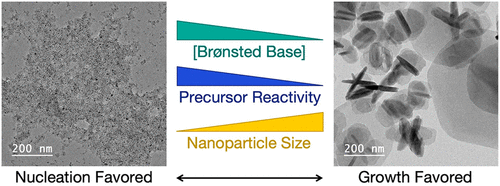当前位置:
X-MOL 学术
›
J. Am. Chem. Soc.
›
论文详情
Our official English website, www.x-mol.net, welcomes your
feedback! (Note: you will need to create a separate account there.)
Amide-Assisted Synthesis of Iron Germanium Sulfide (Fe2GeS4) Nanostars: the Effect of LiN(SiMe3)2 on Precursor Reactivity for Favoring Nanoparticle Nucleation or Growth
Journal of the American Chemical Society ( IF 14.4 ) Pub Date : 2020-03-26 , DOI: 10.1021/jacs.0c00260 Rebecca C. Miller 1 , James R. Neilson 1 , Amy L. Prieto 1
Journal of the American Chemical Society ( IF 14.4 ) Pub Date : 2020-03-26 , DOI: 10.1021/jacs.0c00260 Rebecca C. Miller 1 , James R. Neilson 1 , Amy L. Prieto 1
Affiliation

|
Olivine Fe2GeS4 has been identified as a promising photovoltaic absorber material introduced as an alternate candidate to iron pyrite, FeS2. The compounds share similar benefits in terms of elemental abundance and relative non-toxicity, but Fe2GeS4 was predicted to have higher stability with respect to decomposition to alternate phases and, therefore, more optimal device performance. Our initial report of the nanoparticle (NP) synthesis for Fe2GeS4 was not well understood and required an inefficient 24 h growth to dissolve an impurity phase. Here, we report an improved, amide-assisted Fe2GeS4 NP synthesis that directly forms the phase-pure product in minutes. This significant advance in the quality of the reaction was achieved by the replacement of the poorly-understood hexamethyldisilazane (HMDS) additive and TMS2S by its conjugate base, lithium bis(trimethylsilyl)amide (LiN(SiMe3)2) and elemental S, respectively. We hypothesized that fragments of both TMS2S and HMDS had carried out the roles that Brønsted bases play in amide-assisted NP syntheses and were necessary for Ge incorporation. Convolution of this role with the supply of S in TMS2S caused the iron sulfide impurities. Separating these effects in the use of LiN(SiMe3)2 and elemental S resulted in synthetic control over the ternary phase. Herein we explore the Fe-Ge-S reaction landscape and the role of the base. Its concentration was found to increase the reactivities of the Fe, Ge, and S precursors, and we discuss possible metal-amide intermediates. This affords tunability in two areas: favorability of NP nucleation versus growth and phase formation. The phase-purity of Fe2GeS4 depends on the molar ratios of the cations, base, and amine as well as the Fe:Ge:S molar ratios. The resultant Fe2GeS4 NPs exhibit an interesting star anise-like morphology with stacks of nanoplates that intersect along a 6-fold rotation axis. The optical properties of the Fe2GeS4 NPs are con-sistent with previously published measurements showing a measured band gap of 1.48 eV.
中文翻译:

酰胺辅助合成铁锗硫化物 (Fe2GeS4) 纳米星:LiN(SiMe3)2 对有利于纳米颗粒成核或生长的前体反应性的影响
橄榄石 Fe2GeS4 已被确定为一种很有前途的光伏吸收材料,作为黄铁矿 FeS2 的替代候选材料引入。这些化合物在元素丰度和相对无毒性方面具有相似的优势,但预计 Fe2GeS4 在分解为交替相方面具有更高的稳定性,因此具有更优化的器件性能。我们对 Fe2GeS4 的纳米颗粒 (NP) 合成的初步报告尚不清楚,需要低效的 24 小时生长才能溶解杂质相。在这里,我们报告了一种改进的、酰胺辅助的 Fe2GeS4 NP 合成方法,可在几分钟内直接形成相纯产品。通过用共轭碱替代鲜为人知的六甲基二硅氮烷 (HMDS) 添加剂和 TMS2S,实现了反应质量的显着进步,锂双(三甲基甲硅烷基)酰胺(LiN(SiMe3)2)和元素S,分别。我们假设 TMS2S 和 HMDS 的片段都发挥了 Brønsted 碱基在酰胺辅助 NP 合成中的作用,并且是 Ge 掺入所必需的。这种作用与 TMS2S 中 S 的供应的叠加导致了硫化铁杂质。在使用 LiN(SiMe3)2 和元素 S 时分离这些影响导致对三元相的综合控制。在这里,我们探讨了 Fe-Ge-S 反应格局和碱的作用。发现其浓度会增加 Fe、Ge 和 S 前体的反应性,我们讨论了可能的金属-酰胺中间体。这提供了两个方面的可调性:NP 成核与生长和相形成的有利性。Fe2GeS4 的相纯度取决于阳离子的摩尔比,碱和胺以及 Fe:Ge:S 摩尔比。由此产生的 Fe2GeS4 NPs 表现出有趣的八角形形态,纳米片堆叠沿 6 倍旋转轴相交。Fe2GeS4 NPs 的光学特性与之前公布的测量结果一致,显示测量的带隙为 1.48 eV。
更新日期:2020-03-26
中文翻译:

酰胺辅助合成铁锗硫化物 (Fe2GeS4) 纳米星:LiN(SiMe3)2 对有利于纳米颗粒成核或生长的前体反应性的影响
橄榄石 Fe2GeS4 已被确定为一种很有前途的光伏吸收材料,作为黄铁矿 FeS2 的替代候选材料引入。这些化合物在元素丰度和相对无毒性方面具有相似的优势,但预计 Fe2GeS4 在分解为交替相方面具有更高的稳定性,因此具有更优化的器件性能。我们对 Fe2GeS4 的纳米颗粒 (NP) 合成的初步报告尚不清楚,需要低效的 24 小时生长才能溶解杂质相。在这里,我们报告了一种改进的、酰胺辅助的 Fe2GeS4 NP 合成方法,可在几分钟内直接形成相纯产品。通过用共轭碱替代鲜为人知的六甲基二硅氮烷 (HMDS) 添加剂和 TMS2S,实现了反应质量的显着进步,锂双(三甲基甲硅烷基)酰胺(LiN(SiMe3)2)和元素S,分别。我们假设 TMS2S 和 HMDS 的片段都发挥了 Brønsted 碱基在酰胺辅助 NP 合成中的作用,并且是 Ge 掺入所必需的。这种作用与 TMS2S 中 S 的供应的叠加导致了硫化铁杂质。在使用 LiN(SiMe3)2 和元素 S 时分离这些影响导致对三元相的综合控制。在这里,我们探讨了 Fe-Ge-S 反应格局和碱的作用。发现其浓度会增加 Fe、Ge 和 S 前体的反应性,我们讨论了可能的金属-酰胺中间体。这提供了两个方面的可调性:NP 成核与生长和相形成的有利性。Fe2GeS4 的相纯度取决于阳离子的摩尔比,碱和胺以及 Fe:Ge:S 摩尔比。由此产生的 Fe2GeS4 NPs 表现出有趣的八角形形态,纳米片堆叠沿 6 倍旋转轴相交。Fe2GeS4 NPs 的光学特性与之前公布的测量结果一致,显示测量的带隙为 1.48 eV。











































 京公网安备 11010802027423号
京公网安备 11010802027423号